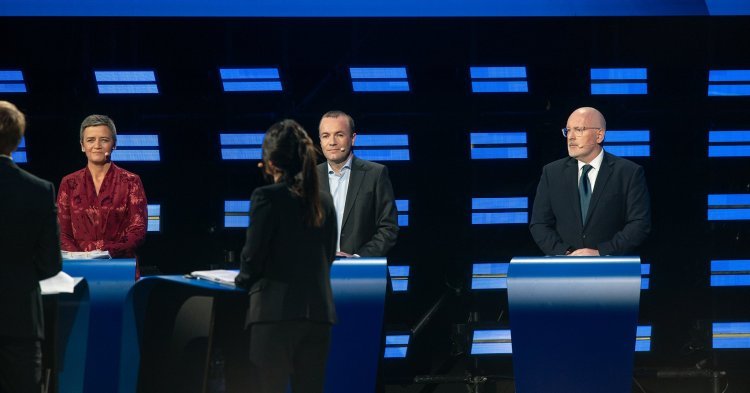The unresolved tensions around these questions turned the nomination for the Commission President and other “EU top jobs” into a lengthy drama after the elections, with national leaders spending multiple sleepless nights in a closed negotiating room in Brussels. Emerging as a victorious black horse from the race for Commission President, Ursula von der Leyen announced a “Conference on the Future of Europe” as a way to find solutions to the institutional puzzles.
In other words, once the Conference kicks off, we will likely have new debates on how the Spitzenkandidaten system is meant to work, and whether there should be an EU-wide constituency in the next European elections. On the face of it, it might sound like an attractive proposal to fuse these two ideas together. Doing so, however, would risk forgetting that they are meant to serve two different purposes. Even worse, merging Spitzenkandidaten with transnational lists would risk stoking renewed confusion about what type of a system the EU is supposed to be.
EU-wide candidates for EU-wide lists?
Having Spitzenkandidaten heading their respective Europarties’ lists in the transnational constituency might sound like a popular idea. In 2019, when the main candidates were the conservative Manfred Weber and the socialist Frans Timmermans, voters outside Germany and the Netherlands could not see either of them on the lists of candidates hung up inside the polling booths. Next time, the argument goes, every EU citizen could have a chance to cast a vote for a presidential candidate.
Some might take this even further, arguing that the candidate whose party comes first in an EU-wide constituency should have a legitimate claim for the Commission presidency. In effect, such an idea would implicitly embed a separate EU presidential election within the elections to the European Parliament – turning the EU into a presidential system by stealth. For those who want to envisage the EU as a presidential system, something akin to France or the United States, the most logical choice would instead be to act transparently, and announce separate presidential elections in their own right. This, of course, would require major overhaul of the EU treaties, as well as soul-searching about how Europeans want their representative democracies to be run.
The current direction of travel is different
The EU is a famously ambiguous construction. Bright minds disagree on whether the EU is an international organisation, an emerging state, or something different altogether. Similarly, reasonable people can disagree on whether the EU ought to be a presidential system where its head (in this case, the Commission President) is elected directly by the people; a parliamentary system where its claim to leadership is underpinned by the European Parliament’s confidence; or something else altogether. The confusion around what the Spitzenkandidaten process is intended to mean can be read as an example of this latter disagreement: if you believed that Spitzenkandidaten is a step towards a ‘presidential’ EU, you would of course not accept the idea that the candidate of the second-largest party could become the President.
However, the wild summer of 2019 brought us further away from a presidential EU, and closer to a parliamentary one. Within the European Parliament, advocates of (one particular version of) the Spitzenkandidaten idea rejected Manfred Weber’s bid for thepresidency, in a reminder that even a Spitzenkandidat must first visit the parliamentary chamber before getting keys to the Commission’s headquarters. The EU is not France, where ‘the people’ open the presidential palace’s doors to the winning contender.
What are transnational lists good for?
In parliamentary systems across Europe, the candidates for Prime Minister only stand for election in one place. Only the people of Uxbridge and South Ruislip were able to vote for Boris Johnson in the last British election. Pedro Sánchez stood for the Spanish Parliament in Madrid. Yet unlike the case of Weber or Timmermans in the European elections, you don’t hear Brits or Spaniards complaining about not being able to cast their vote for the leader. A key reason for this is that Johnson and Sánchez were visible all across the country during the campaign, while the same cannot be said of Weber or Timmermans on an EU-wide scale.
In turn, one reason why the Spitzenkandidaten have not had enough visibility across Europe is the weakness of the European-level party system. For example, most national member parties of Weber’s EPP didn’t actively campaign for him on the streets during the elections – indeed, the Hungarian leader Viktor Orbán and his Fidesz party seemed to rather campaign against him.
A key intended advantage of transnational lists is the increased cohesion within the European-level party alliances: within the pan-EU constituency, each Europarty will work together as one team, which brings national-level parties closer to their European-level umbrella organisations. In more academic terms, transnational lists foster the development of a true European-level party system, which in turn is essential for EU-level democracy to work optimally.
Put briefly, the two grand ideas for improving European democracy serve two mutually reinforcing, yet distinct objectives. Spitzenkandidaten are about ensuring that the Commission President has a democratic mandate – and experience from 2019 suggests that more precisely, the mandate is an indirect one, based on parliamentary support. For their part, transnational lists are about turning Europarties into more cohesive organisations than before.
If we assigned transnational lists with the objective of conferring a democratic mandate to the Commission President, we would run the risk of inserting a presidential element into an otherwise parliamentary system, creating a strange hybrid. If in a future election the Spitzenkandidaten do stand for election in the EU-wide constituency, we should be clear that the choice of Commission President (just like the composition of the European Parliament) depends on the election results in their entirety – not just on what happens in the EU-wide constituency, which is only one constituency among the others. We would thus avoid inappropriately “fusing” the Spitzenkandidaten principle and transnational lists together.
A possible source of confusion: “Some are more European than others”
To avoid the EU-wide constituency misleadingly acquiring a special, “President-making” status in voters’ minds, it would be unwise to oblige the Spitzenkandidaten to stand for election in the EU-wide constituency. After the introduction of transnational lists, the European elections would have two types of constituencies – European and (sub)national –, each of which are equally valid. (A partially fitting analogy is the Scottish Parliament, where each voter has two votes, and the First Minister may come from either a single-member local constituency, or a multi-member regional constituency.) As long as a Spitzenkandidat can ensure that her ideas gain visibility all across Europe, nothing should stop her from standing for election in Slovenia.
However, this can result in undesirable scenarios where, for example, the EPP’s Spitzenkandidat stands for election in the EU-wide constituency, while the socialist candidate seeks election from a national constituency. As a result, most citizens would be able to personally vote for some Spitzenkandidaten, but not for the others. If candidates were to draw attention to this discrepancy, weaponising it during the campaign, citizens might face a new type of confusing situation related to the European elections.
As ever, achieving a well-functioning EU-level democracy remains a complicated task which requires institutional innovation. While the various ideas on the table have both their pros and cons, being precise about how the ideas are defined helps to maximise the upsides. Definitional precision helps clarify the system to citizens, and reduces the risk of post-election backroom quarrels caused by misunderstandings that were left unaddressed before the campaign period. At its best, the Conference on the Future of Europe might be just the right arena for determining the way forward.


Follow the comments: |
|
